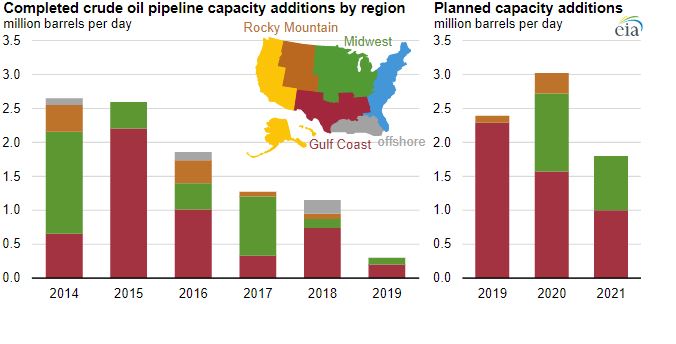EIA recently launched a new liquids pipeline projects database that tracks more than 200 crude oil, hydrocarbon gas liquids (HGL), and petroleum products pipeline projects. Rising domestic crude oil production has led to several changes in Gulf Coast crude oil supply and demand patterns, creating a need for more pipeline capacity. Crude oil pipeline capacity additions originating in the Gulf Coast region represent most of the scheduled pipeline capacity growth over the next few years. EIA's new database provides an improved capability to track this growth.

Source: U.S. Energy Information Administration liquids pipeline projects database
The database contains project information such as project type, start dates, capacity, mileage, and geographic information for historical pipeline projects (completed since 2010) and future pipeline projects. The information in the database is based on the latest public information from company documents, government filings, and trade press, and it does not reflect EIA's assumptions on the likelihood or timing of project completion.

Source: U.S. Energy Information Administration, Petroleum Supply Monthly
U.S. crude oil production doubled between 2010 and 2018, with about 70% of that growth coming from the Gulf Coast region. U.S. Gulf Coast crude oil production grew from 5.2 million barrels per day (b/d) in 2014 to 7.1 million b/d in 2018, driven by production in the Permian Basin in western Texas and southeastern New Mexico.
As U.S. crude oil production increased, imports dropped off significantly. Previously, Gulf Coast crude imports were shipped to refineries in the region, and they also moved north by pipeline to refineries in the Midwest. But as import volumes declined, less pipeline capacity was needed from the Gulf Coast to the Midwest. New pipelines and reversals of existing pipelines originating in the Midwest are increasingly moving crude oil south from the Bakken region in Montana and North Dakota, as well as from Canada, to the Gulf Coast. As a result, the Gulf Coast transitioned from being a net shipper to a net recipient of crude oil from elsewhere in the country in 2015.
More recently, increasing Permian crude production has outpaced pipeline takeaway capacity to bring the crude oil to market. The increasing crude oil production and need for more pipeline transportation capacity prompted a large expansion of crude oil pipeline infrastructure. In the region, nine intrastate crude oil pipeline projects have been announced or are under construction with in-service dates between 2019–2021. These projects are planned to move crude oil throughout Texas and Louisiana to further alleviate regional constraints.
EIA will update the liquids pipeline projects database twice a year, at the end of May and November (data will be vintaged to the end of April and October, respectively). Projects will be added or modified depending on best available information. The liquids pipeline projects database complements EIA's natural gas pipeline projects table.
Source: EIA